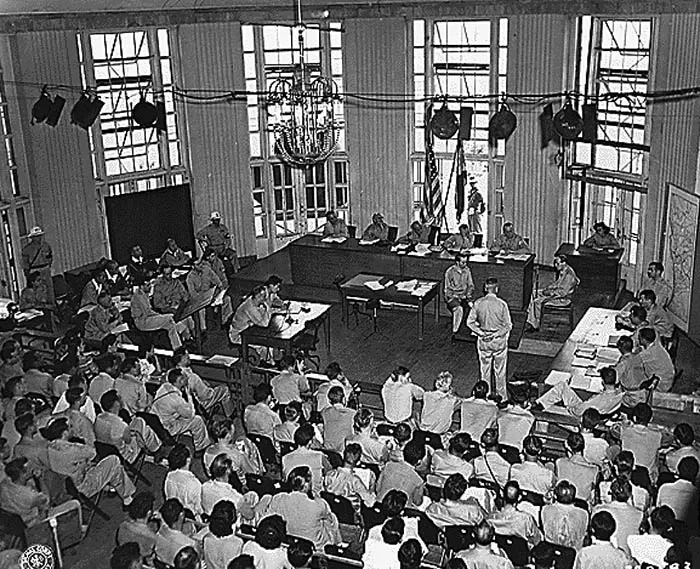Testimony of Ueno Tamehaya in War Crimes Trial on Charges of Atrocities Committed in Batangas in 1945
[TRANSCRIPTION]
This page contains the transcription of the testimony of Ueno Tamehaya for the defense in U.S.A. v Shumpei Hagino, et al., one of the trials of personnel of the Imperial Japanese Army for war crimes involving atrocities committed in the Province of Batangas. The pages contained herein are now declassified and were part of compiled documentation1 of war crimes trials conducted by the United States Military Commission after the conclusion of World War II. This transcription has been corrected for grammar where necessary by Batangas History, Culture and Folklore. The pagination is as it was contained in the original document for citation purposes.
 |
| Photo taken during the war crimes trials in Manila. Image credit: U.S. National Archives. |
[p. 231]
UENO TAMEHAYA
a witness for the defense, being first duly sworn, testified as follows through Interpreters Taccad and Nishihara:
DIRECT-EXAMINATION
MR. MORRISON: Will the prosecution please advise the witness of his rights against self incrimination?
MR. GUTHRIE: State your name for the record.
THE WITNESS: Ueno Tamehaya.
MR. GUTHRIE: At the present time, you are a prisoner of war, is that correct?
THE WITNESS: Yes.
MR. GUTHRIE: I will advise you that as a witness in these proceedings, you have certain rights. Among those rights is the right that you shall not be compelled to give any answer which would tend to discredit you or incriminate you in any later criminal proceeding. I will further advise you that you must in each instance claim that right. Do you understand the explanation of your rights as I have just stated them to you?
THE WITNESS: Yes.
Q Were you a member of the Japanese Armed Forces?
A Yes.
Q What was your rank?
A First Lieutenant.
Q What was your organization?
A The Ichimura unit.
[p. 232]
A Yes.
Q What were your duties in that battalion?
A Medical Officer.
Q Did you ever treat any members of that organization for wounds in February, 1945?
A Yes.
Q Can you remember having treated anyone by name in February 16, 17 or 18, 1945?
A I do not remember the names.
Q Do you remember having treated any officers for wounds on those dates?
A Yes.
Q What was the name, or names, of the officers you treated on February 16, 17 or 18, 1945?
A The dates might be a little off. However, I recall that I treated First Lieutenant Hagino.
Q Do you know the nature of Hagino’s wound?
A It was a flesh wound caused by a bullet.
Q Did he say who inflicted the wound?
MR. GUTHRIE: This is objected to as not the best evidence. Hagino is present in court. He can testify about his own wound much better than the doctor, except as to the nature of the wound and the medical condition of the wound, but as to who inflicted the wound, Hagino’s testimony is the best evidence.
COLONEL HAMBY: The Law Member will rule.
COLONEL POBLETE: Objection overruled. The
[p. 233]
A He said that he was attacked by guerrillas.
Q Did you treat any other members of the second battalion on February 16, 17 or 18, 1945, for wounds inflicted by guerrillas and, if so, how many men did you treat for wounds?
A Yes, I did. However, I do not remember the dates.
Q How many men did you treat from the second battalion for wounds inflicted by guerrillas?
A I remember that there were between twenty and thirty.
Q Where were you stationed at the time you treated these wounded men?
A At Dita.
Q How is it that these men were treated in Dita for wounds?
A That was because the dispensary was at Dita.
Q Did you treat all wounds sustained by your men, regardless of their severity?
A Yes.
Q Will you tell us again the date that you treated Hagino for his wound?
A It was in the month of February, but I do not remember the date.
Q Did you treat any casualties sustained in the Taal expedition which took place on or about February 16, 17 or 18, 1945?
A Yes.
Q How many did you treat?
A I remember that I reported about seven or eight.
[p. 234]
CROSS-EXAMINATION
Q These wounds you talk about, you don’t know how they were incurred, do you?
A No, I do not. I heard about them later from the patients themselves.
Q They could have been incurred by American planes strafing the Japanese troops, could they not?
A The patients I have mentioned before, there were no possibilities of such wounds.
Q Why?
A That is because I heard from the patients themselves that they were wounded by the guerrillas.
Q But you don’t know except for what they told you, but that the planes might have strafed them?
A Yes.
Q Were you there when they were wounded?
A No.
Q You don’t know whether you treated Lieutenant Hagino before the 16th, 17th or 18th of February or during those days or whether it was after that time?
A I am not clear as to the dates.
MR. GUTHRIE: That is all.
MR. MORRISON: No further questions, sir.
COLONEL HAMBY: Any questions by members of the Commission? There appear to be none. The witness is excused.
